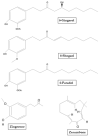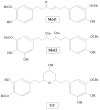Ginger, a Possible Candidate for the Treatment of Dementias?
- PMID: 34577171
- PMCID: PMC8470323
- DOI: 10.3390/molecules26185700
Ginger, a Possible Candidate for the Treatment of Dementias?
Abstract
As the human life expectancy increases, age-linked diseases have become more and more frequent. The worldwide increment of dementia cases demands medical solutions, but the current available drugs do not meet all the expectations. Recently the attention of the scientific community was attracted by natural compounds, used in ancient medicine, known for their beneficial effects and high tolerability. This review is focused on Ginger (Zingiber officinale) and explore its properties against Alzheimer's Disease and Vascular Dementia, two of the most common and devastating forms of dementia. This work resumes the beneficial effects of Ginger compounds, tested in computational in vitro and in vivo models of Alzheimer's Disease and Vascular Dementia, along with some human tests. All these evidences suggest a potential role of the compounds of ginger not only in the treatment of the disease, but also in its prevention.
Keywords: Alzheimer’s disease; dementia; ginger; neurodegeneration; neuroinflammation; neuroprotection; vascular dementia.
Conflict of interest statement
The authors declare no conflict of interest.
Figures





Similar articles
-
Update on the chemopreventive effects of ginger and its phytochemicals.Crit Rev Food Sci Nutr. 2011 Jul;51(6):499-523. doi: 10.1080/10408391003698669. Crit Rev Food Sci Nutr. 2011. PMID: 21929329 Review.
-
Anti-tumor-promoting activities of selected pungent phenolic substances present in ginger.J Environ Pathol Toxicol Oncol. 1999;18(2):131-9. J Environ Pathol Toxicol Oncol. 1999. PMID: 15281225
-
Cancer preventive properties of ginger: a brief review.Food Chem Toxicol. 2007 May;45(5):683-90. doi: 10.1016/j.fct.2006.11.002. Epub 2006 Nov 12. Food Chem Toxicol. 2007. PMID: 17175086 Review.
-
Modulation of macrophage functions by compounds isolated from Zingiber officinale.Planta Med. 2009 Feb;75(2):148-51. doi: 10.1055/s-0028-1088347. Epub 2008 Nov 24. Planta Med. 2009. PMID: 19031369
-
Identification of unprecedented purine-containing compounds, the zingerines, from ginger rhizomes (Zingiber officinale Roscoe) using a phase-trafficking approach.Phytochemistry. 2011 Jun;72(9):935-41. doi: 10.1016/j.phytochem.2011.03.007. Epub 2011 Apr 15. Phytochemistry. 2011. PMID: 21497863 Free PMC article.
Cited by
-
Trichosanthis Semen and Zingiberis Rhizoma Mixture Ameliorates Lipopolysaccharide-Induced Memory Dysfunction by Inhibiting Neuroinflammation.Int J Mol Sci. 2022 Nov 13;23(22):14015. doi: 10.3390/ijms232214015. Int J Mol Sci. 2022. PMID: 36430493 Free PMC article.
-
Pharmacological properties of ginger (Zingiber officinale): what do meta-analyses say? a systematic review.Front Pharmacol. 2025 Jul 30;16:1619655. doi: 10.3389/fphar.2025.1619655. eCollection 2025. Front Pharmacol. 2025. PMID: 40808693 Free PMC article.
-
Natural Polyphenols as SERCA Activators: Role in the Endoplasmic Reticulum Stress-Related Diseases.Molecules. 2022 Aug 10;27(16):5095. doi: 10.3390/molecules27165095. Molecules. 2022. PMID: 36014327 Free PMC article. Review.
-
Extraction, Purification, Structural Characteristics, Biological Activities, and Applications of the Polysaccharides from Zingiber officinale Roscoe. (Ginger): A Review.Molecules. 2023 May 2;28(9):3855. doi: 10.3390/molecules28093855. Molecules. 2023. PMID: 37175266 Free PMC article.
-
A Review on Phyto-Therapeutic Approaches in Alzheimer's Disease.J Funct Biomater. 2023 Jan 16;14(1):50. doi: 10.3390/jfb14010050. J Funct Biomater. 2023. PMID: 36662097 Free PMC article. Review.
References
Publication types
MeSH terms
Substances
Grants and funding
LinkOut - more resources
Full Text Sources
Medical
Research Materials

